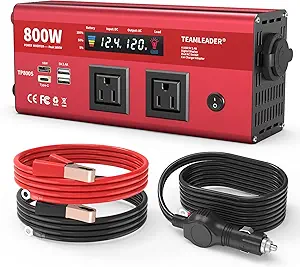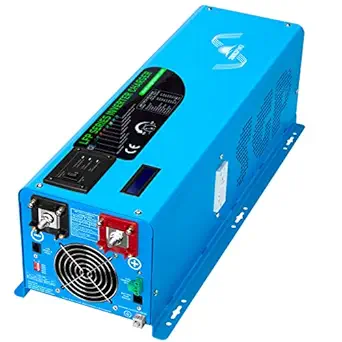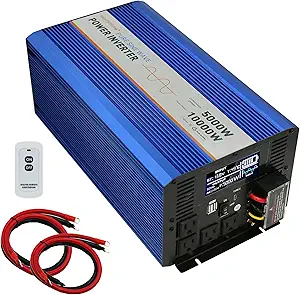This is a great start to a detailed guide on power inverters! Here’s an outline for how you could expand on each section further in your comprehensive guide:
Power Inverters: An In-Depth Guide
What is a Power Inverter?
Overview of the importance and applications of power inverters.
Differentiation between DC and AC power, and why the conversion is necessary.
Emphasize real-world examples, such as using inverters in off-grid solar systems or for emergency backup power.
- How Does a Power Inverter Work?
- Types of Power Inverters

DC vs. AC Power
A deeper look at the nature of direct current (DC) and alternating current (AC).
Explain why most household and commercial appliances are designed for AC.
The Conversion Process
Go into more detail on how oscillators create a square wave.
Explain the role of transformers in adjusting voltage and filters in waveform shaping.
Diagram or schematic showing the stages in the conversion process could be helpful here.
Square Wave Inverters
Brief description of square waveforms and how they are generated.
Pros (simple design, low cost) and cons (not suitable for sensitive electronics).
Applications: Limited to simpler devices like basic motors and lights.
Modified Sine Wave Inverters
Explanation of the “modified sine wave” and how it improves upon the square wave.
Pros (suitable for most devices, affordable) and cons (still not ideal for all sensitive electronics).
Applications: Common in RVs, trucks, and backup power supplies for general electronics.
Pure Sine Wave Inverters
Description of how pure sine waves mimic the AC power from a power grid.
Pros (safe for all devices, efficient) and cons (more expensive).
Applications: Required for sensitive electronics like medical equipment, computers, and newer energy-efficient devices.
- Common Applications of Power Inverters
Backup Power Systems
How inverters are used in home backup systems to keep essential devices running during power outages.
Renewable Energy Systems
Solar, wind, and hybrid systems that rely on inverters to convert DC from batteries or panels into usable AC.
Grid-tie inverters, used to connect solar or wind systems to the main power grid.
Portable and Mobile Power

Use in RVs, vehicles, and camping setups for portable power on the go.
Inverters in marine applications, for powering appliances on boats.
Industrial and Commercial Uses
Role of inverters in remote locations, large-scale energy setups, and for powering specialized equipment.
- Choosing the Right Power Inverter
Factors to consider: power requirements, inverter efficiency, battery compatibility, output waveform, and total load capacity.
Safety considerations, such as built-in protection against overload, overheating, and short-circuiting.
- Maintenance and Safety Tips
Regular maintenance practices for inverters, especially those in continuous-use systems.
Safety tips for handling, installation, and ventilation of inverters to prevent overheating or electrical hazards.
- Emerging Technologies and Future Trends
Recent advancements in inverter technology, such as smart inverters, which can interact with smart home systems and provide grid feedback.
Future of inverters in supporting electric vehicle (EV) integration and advanced renewable energy solutions.
Adding diagrams and visual aids throughout, particularly for the conversion process, types of waveforms, and different inverter types, can help clarify concepts. You could also consider a FAQ section to address common questions about inverter sizing, installation, and troubleshooting. This structure provides a rounded view of power inverters, their operation, and their wide range of applications.
This is a thorough and insightful look into power inverters! You’ve covered everything from types and applications to technological advancements and considerations for selecting the right inverter. Here’s a brief recap of the key points you’ve covered:
Types of Power Inverters: Square wave, modified sine wave, pure sine wave, grid-tie, off-grid, and hybrid inverters, each catering to different applications, requirements, and devices.
Applications: Ranging from residential use and renewable energy systems to EVs and UPS systems, with specific inverter types matching the needs and sensitivities of these applications.
Technological Advancements: New developments such as smart inverters, wide bandgap semiconductors, bi-directional inverters, and modular designs that enhance efficiency, integration, and scalability.

Considerations for Choosing an Inverter: Including factors like power requirements, waveform type, efficiency, durability, battery compatibility, and budget—emphasizing that selection impacts both immediate performance and long-term savings.
Future Trends: Highlighting the ongoing drive for sustainable, efficient, and resilient inverter technology to meet the demands of evolving energy systems.
This provides an invaluable reference for anyone interested in understanding power inverters or making informed decisions in this area. Let me know if you’d like to explore further or dive deeper into any particular area.